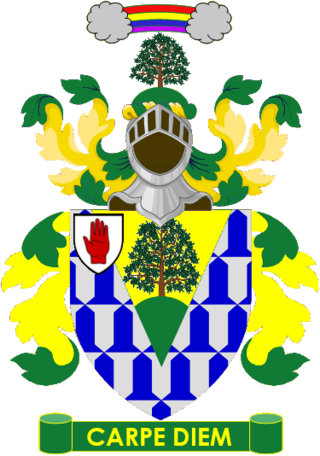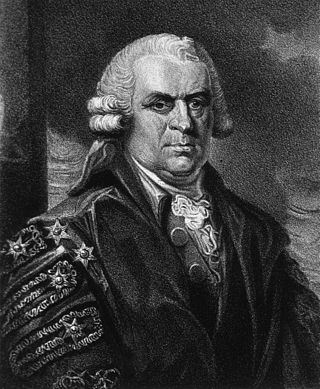
Earl of Lonsdale is a title that has been created twice in British history, firstly in the Peerage of Great Britain in 1784, and then in the Peerage of the United Kingdom in 1807, both times for members of the Lowther family.

Earl of Verulam is a title in the Peerage of the United Kingdom. It was created in 1815 for James Grimston, 4th Viscount Grimston. He was made Viscount Grimston at the same time. Verulam had previously represented St Albans in the House of Commons. In 1808 he had also succeeded his maternal cousin as tenth Lord Forrester. He was succeeded by his son, the second Earl.

Viscount Bangor, of Castle Ward, in County Down, is a title in the Peerage of Ireland.
Baron Denham, of Weston Underwood in the County of Buckingham, is a title in the Peerage of the United Kingdom. It was created in 1937 for Sir George Bowyer, 1st Baronet, a Conservative politician who had earlier represented Buckingham in the House of Commons. He had already been created a baronet, of Weston Underwood, in 1933. Bowyer was a great-great-great-grandson of Sir William Bowyer, 3rd Baronet, of Denham Court. As of 2017 the titles are held by his second but only surviving son, the 2nd Baron, who succeeded in 1948. In 1950 he also succeeded his distant relative in the Bowyer baronetcy, of Denham Court. Like his father, the 2nd Baron Denham was a Conservative politician and one of the ninety elected hereditary peers that remain in the House of Lords after the passing of the House of Lords Act 1999.
Baron Killearn, of Killearn in the County of Stirling, is a title in the Peerage of the United Kingdom. It was created in 1943 for the diplomat Sir Miles Lampson. He was the second son of Norman Lampson, youngest son of Sir Curtis Lampson, 1st Baronet, of Rowfant. Lord Killearn's eldest son, the second Baron, succeeded his second cousin once removed as fourth Baronet in 1971. On his death the titles passed to his half-brother, the third and present holder of the barony and baronetcy.
Parktown is a wealthy suburb of Johannesburg, South Africa, the first suburb north of the inner city. It is affectionately known as one of the Parks, others including Parkview, Parkwood, Westcliff, Parktown North, Parkhurst and Forest Town. Parktown is one of Johannesburg's largest suburbs, neighbouring Hillbrow, Braamfontein and Milpark to the South; Berea and Houghton to the East; Killarney and Forest Town to the North, and Westcliff, Melville and Richmond to the West. Originally established by the Randlords in the 1890s, Parktown is now home to many businesses, hospitals, schools, churches and restaurants, whilst still maintaining quiet residential areas. It is also home to three of the five campuses of the University of the Witwatersrand including the education campus, medical school and Wits Business School. It is located in Region F of the City of Johannesburg Metropolitan Municipality.
Baron Harvey of Tasburgh, of Tasburgh in the County of Norfolk, is a title in the Peerage of the United Kingdom. It was created on 3 July 1954 for the diplomat Sir Oliver Harvey on his retirement as British Ambassador to France. In November the same year he also succeeded his half-brother as fourth Baronet of Crown Point.

The Wigan Baronetcy, of Clare Lawn in Mortlake in the County of Surrey and Purland Chase in Ross in the County of Hereford, is a title in the Baronetage of the United Kingdom. It was created on 9 March 1898 for Frederick Wigan, a Director of the North London Railway. The presumed 6th Baronet, listed in Debrett's Peerage (2015) as the son of the 5th Baronet, has not successfully proven his succession and is consequently not on the Official Roll of the Baronetage.
There have been nine baronetcies created for persons with the surname Lloyd, three in the Baronetage of England, three in the Baronetage of Great Britain and three in the Baronetage of the United Kingdom. Two of the creations are extant as of 2010.
There have been two baronetcies created for persons with the surname St George, both in the Baronetage of Ireland. One creation is extant as of 2010.

The Baker, later Rhodes, later Baker Wilbraham Baronetcy, of Loventor in the County of Devon, is a title in the Baronetage of Great Britain. It was created on 19 September 1776 for George Baker, Physician to George III and President of the Royal College of Physicians. His son, Sir Frederick Francis Baker, 2nd Baronet, FRS was accidentally killed by the vane of a windmill. The fourth Baronet, assumed in 1878 by Royal licence the surname of Rhodes in lieu of his patronymic. He never married and was succeeded by his younger brother, the fifth Baronet. He married Katharine Frances, daughter and heiress of General Sir Richard Wilbraham, nephew of Edward Bootle-Wilbraham, 1st Baron Skelmersdale. In 1900 he assumed by Royal licence the additional surname of Wilbraham. His son, the sixth Baronet, served as First Church Estates Commissioner, as Chancellor of the Dioceses of York, Truro, Chelmsford and Durham and as Vicar-General of the Provinces of York and Canterbury. On his death the title passed to his son, the seventh Baronet. He was High Sheriff of Cheshire in 1963 and also a deputy lieutenant of the county. In 1980 the title passed to his son, Sir Richard Baker Wilbraham, the eighth Baronet, who was Deputy Lieutenant of Cheshire in 1992. Following his death in 2022, he was succeeded Sir Randle Baker Wilbraham, the current 9th Baronet.
The Baker, later Sherston-Baker Baronetcy, of Dunstable House in Richmond in the County of Surrey, is a title in the Baronetage of Great Britain. It was created on 14 May 1796 for Robert Baker, in honour of him raising and maintaining a cavalry regiment of 500 men styled "The Richmond Rangers" for King George III. He was succeeded by his son, the second Baronet. He was a vice-admiral in the Royal Navy. The fourth Baronet was a Recorder of Helston and of Barnstaple and Bideford and a County Court judge. The fifth Baronet assumed by deed poll the additional surname of Sherston in 1923. The Baker family was settled in the Westcountry several centuries before the creation of the baronetcy. A version of the arms used by the Baker baronets is displayed on the mural monument in Dunchideock Church in Devon of Aaron Baker (1620–1683) of Bowhay in the parish of Exminster, Devon, first President of the Madras Presidency.
Charles Robert Sydenham Carew JP was a British Conservative politician.
The baronetcy of Wilbraham of Woodhey, Cheshire, was created by James I on 5 May 1621 in the Baronetcy of England for Richard Wilbraham. He was a descendant of the ancient Cheshire family of Radnor who acquired Woodhey by marriage in the 14th century. A junior branch of the family settled at Nantwich, and there was some intermarriage between the two.

Sir George Baker, 1st Baronet, FRS, FSA was physician to King George III.

The statue of Sir Wilfrid Lawson (1829–1906) is an outdoor sculpture by David McGill, installed in Victoria Embankment Gardens in London, United Kingdom. The monument's allegorical sculptures depicting Charity, Fortitude, Peace, and Temperance were stolen in 1979.

The Lyttelton family is a British aristocratic family. Over time, several members of the Lyttelton family were made knights, baronets and peers. Hereditary titles held by the Lyttelton family include the viscountcies of Cobham and Chandos, as well as the Lyttelton barony and Lyttelton baronetcy. Several other members of the family have also risen to prominence, particularly in the field of cricket.